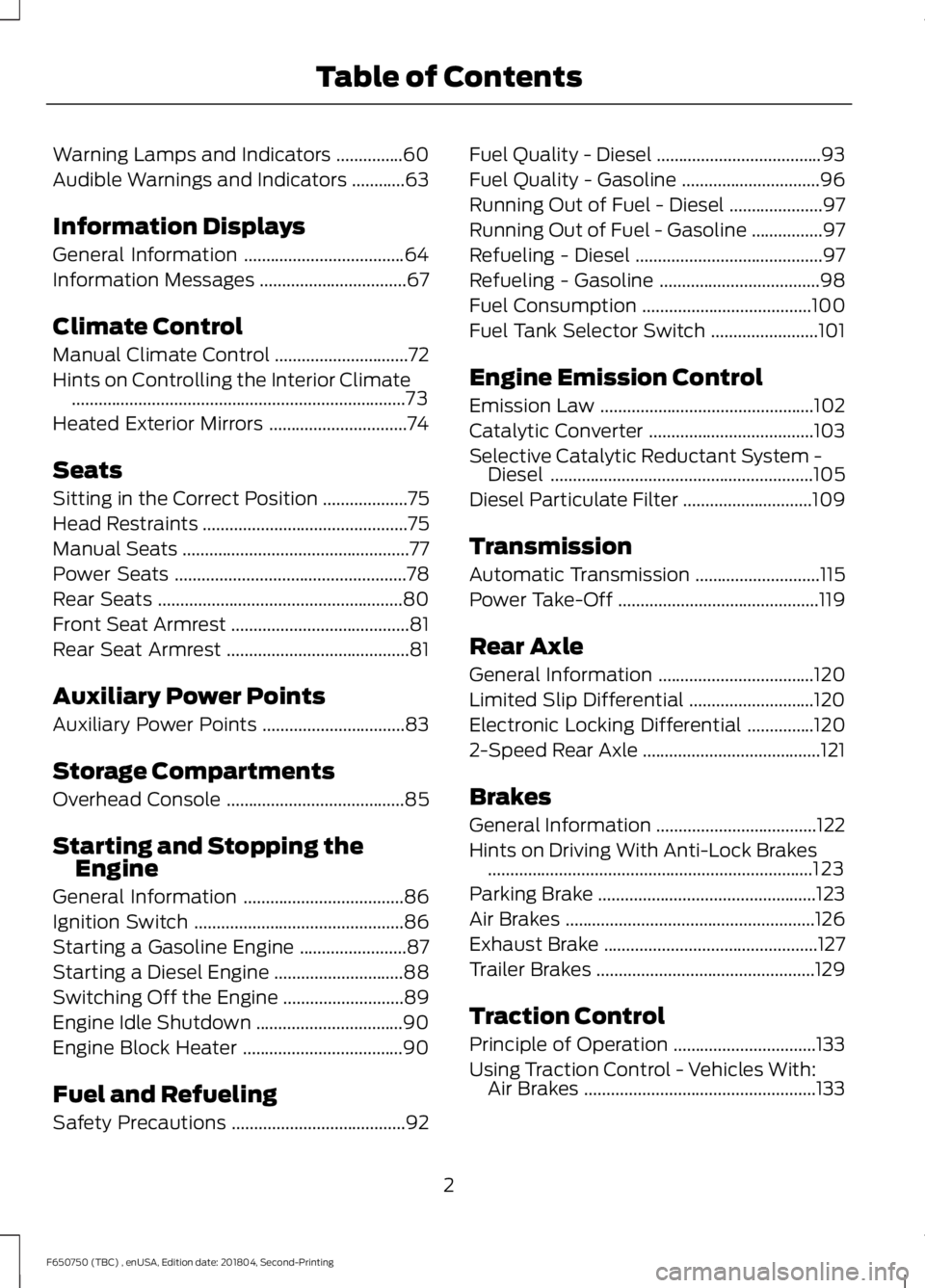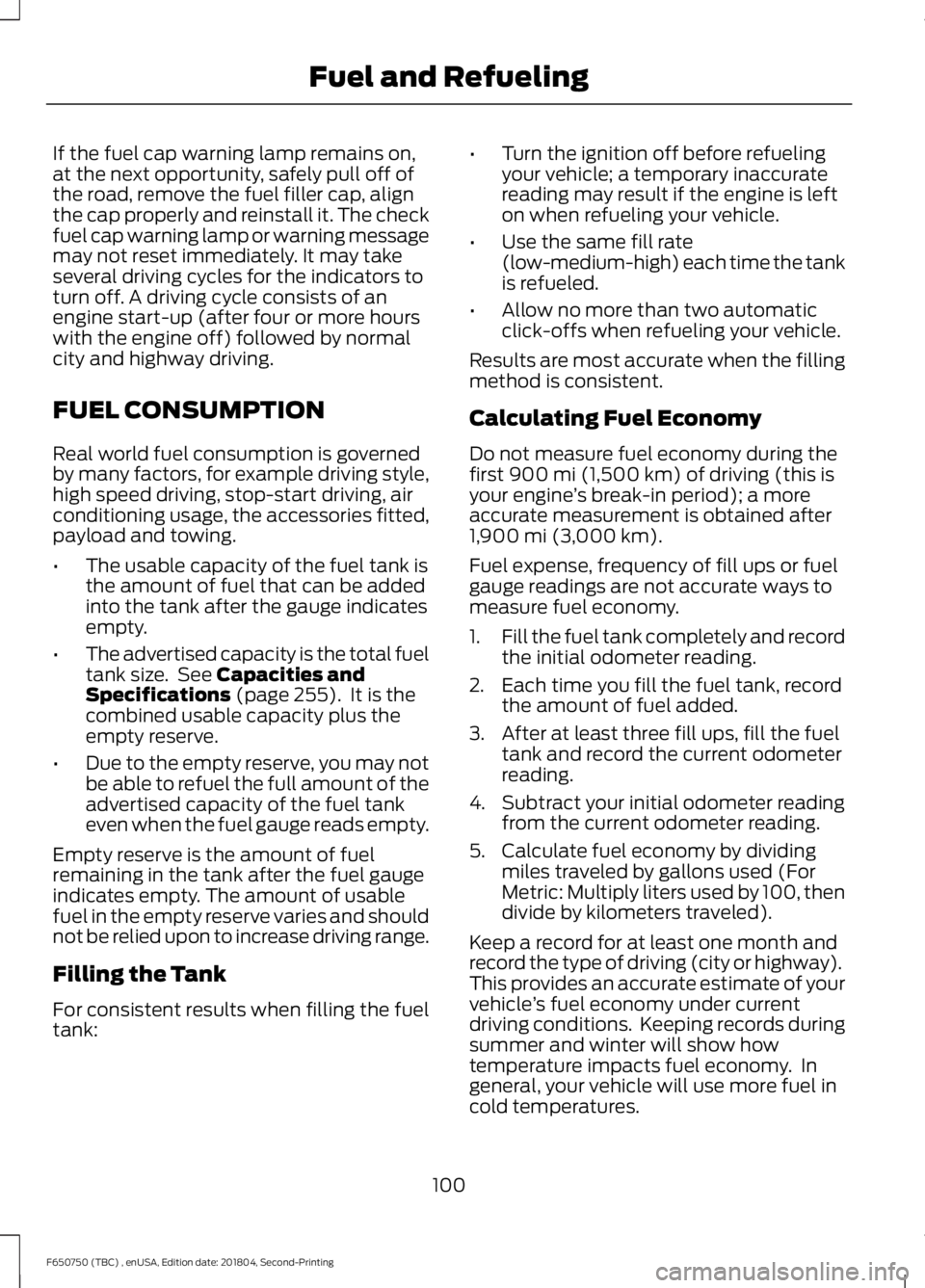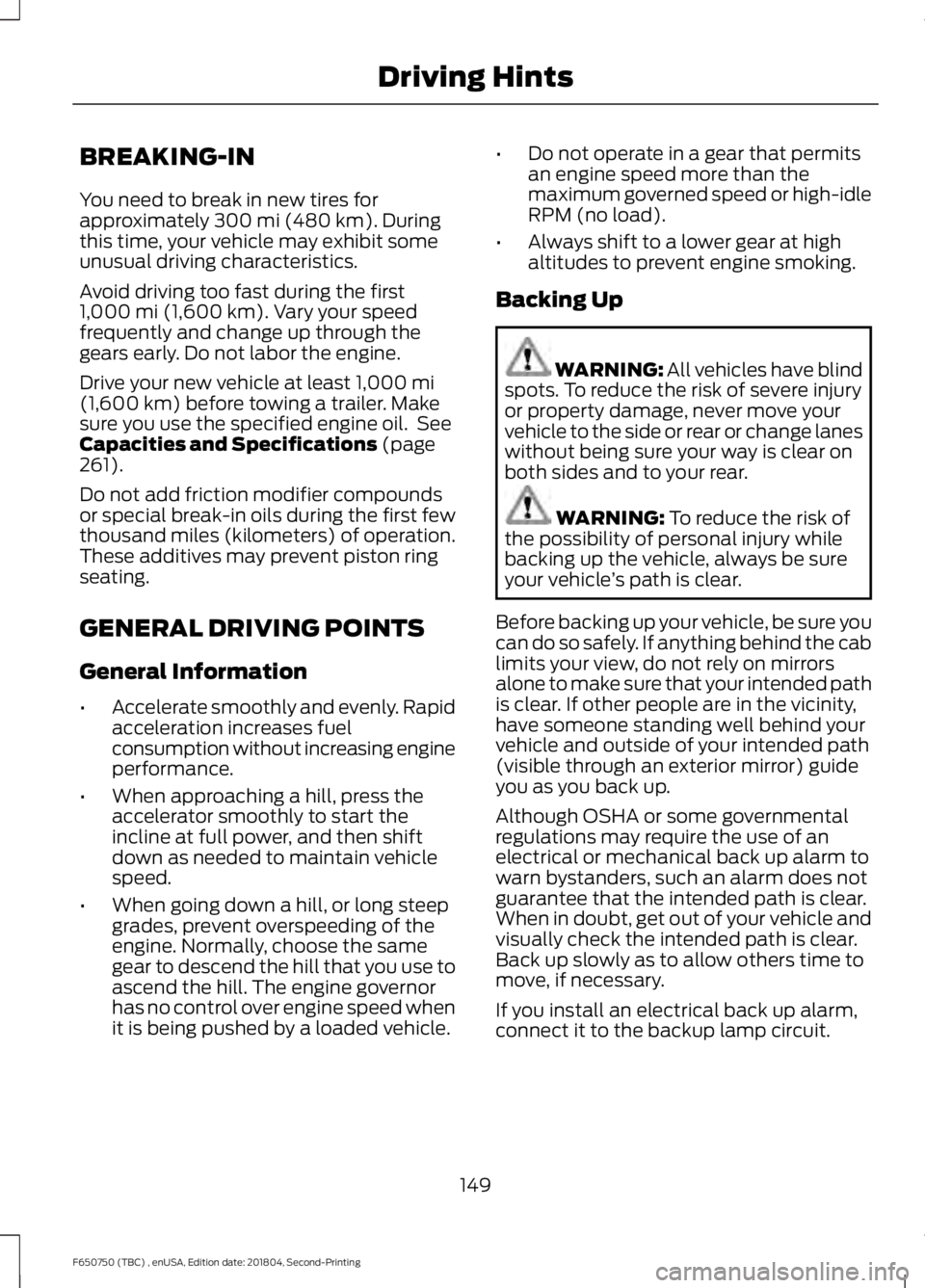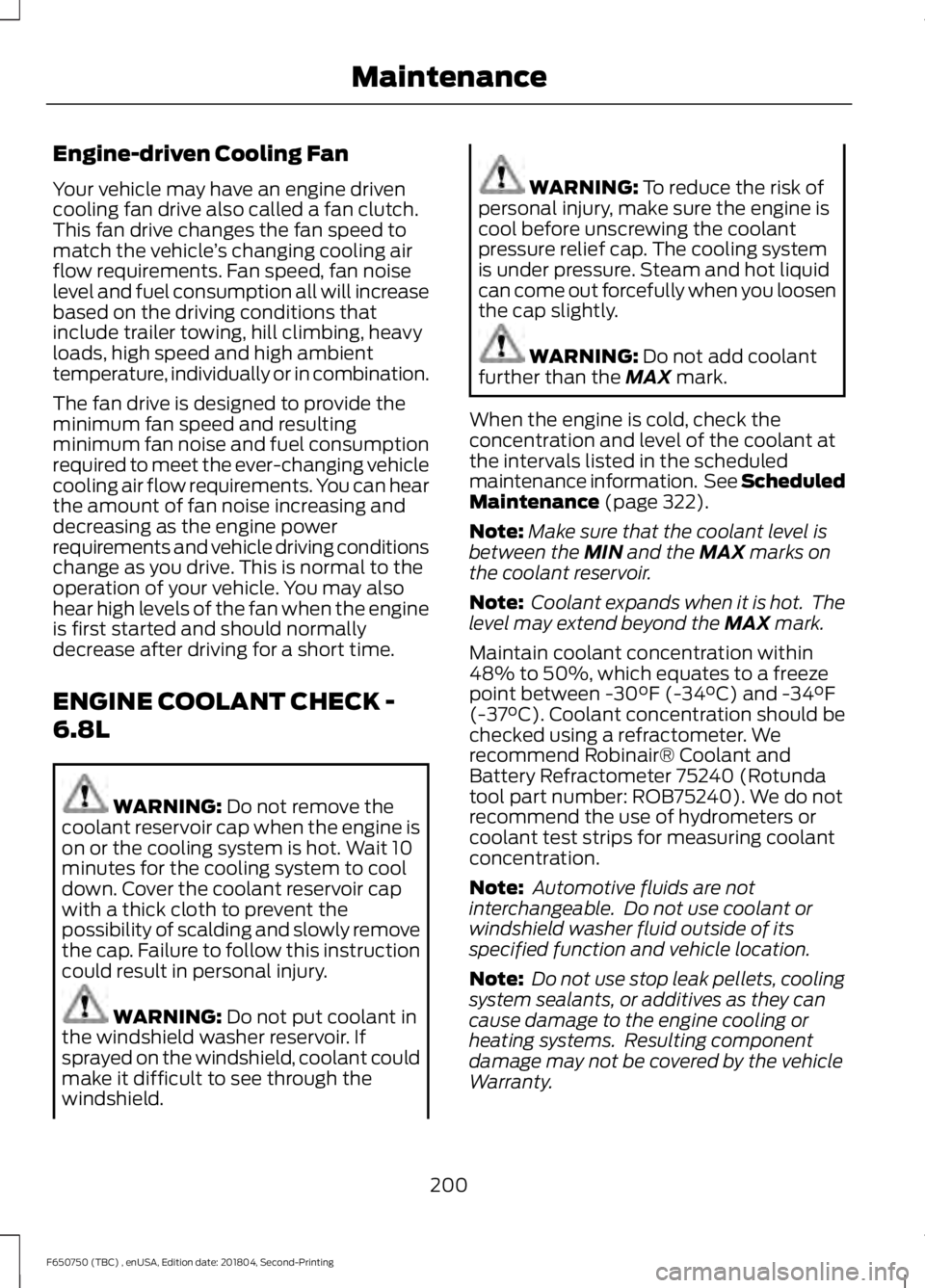2019 FORD F650/750 fuel consumption
[x] Cancel search: fuel consumptionPage 5 of 387

Warning Lamps and Indicators
...............60
Audible Warnings and Indicators ............
63
Information Displays
General Information ....................................
64
Information Messages .................................
67
Climate Control
Manual Climate Control ..............................
72
Hints on Controlling the Interior Climate ........................................................................\
...
73
Heated Exterior Mirrors ...............................
74
Seats
Sitting in the Correct Position ...................
75
Head Restraints ..............................................
75
Manual Seats ...................................................
77
Power Seats ....................................................
78
Rear Seats .......................................................
80
Front Seat Armrest ........................................
81
Rear Seat Armrest .........................................
81
Auxiliary Power Points
Auxiliary Power Points ................................
83
Storage Compartments
Overhead Console ........................................
85
Starting and Stopping the Engine
General Information ....................................
86
Ignition Switch ...............................................
86
Starting a Gasoline Engine ........................
87
Starting a Diesel Engine .............................
88
Switching Off the Engine ...........................
89
Engine Idle Shutdown .................................
90
Engine Block Heater ....................................
90
Fuel and Refueling
Safety Precautions .......................................
92Fuel Quality - Diesel
.....................................
93
Fuel Quality - Gasoline ...............................
96
Running Out of Fuel - Diesel .....................
97
Running Out of Fuel - Gasoline ................
97
Refueling - Diesel ..........................................
97
Refueling - Gasoline ....................................
98
Fuel Consumption ......................................
100
Fuel Tank Selector Switch ........................
101
Engine Emission Control
Emission Law ................................................
102
Catalytic Converter .....................................
103
Selective Catalytic Reductant System - Diesel ...........................................................
105
Diesel Particulate Filter .............................
109
Transmission
Automatic Transmission ............................
115
Power Take-Off .............................................
119
Rear Axle
General Information ...................................
120
Limited Slip Differential ............................
120
Electronic Locking Differential ...............
120
2-Speed Rear Axle ........................................
121
Brakes
General Information ....................................
122
Hints on Driving With Anti-Lock Brakes ........................................................................\
.
123
Parking Brake .................................................
123
Air Brakes ........................................................
126
Exhaust Brake ................................................
127
Trailer Brakes .................................................
129
Traction Control
Principle of Operation ................................
133
Using Traction Control - Vehicles With: Air Brakes ....................................................
133
2
F650750 (TBC) , enUSA, Edition date: 201804, Second-Printing Table of Contents
Page 103 of 387

If the fuel cap warning lamp remains on,
at the next opportunity, safely pull off of
the road, remove the fuel filler cap, align
the cap properly and reinstall it. The check
fuel cap warning lamp or warning message
may not reset immediately. It may take
several driving cycles for the indicators to
turn off. A driving cycle consists of an
engine start-up (after four or more hours
with the engine off) followed by normal
city and highway driving.
FUEL CONSUMPTION
Real world fuel consumption is governed
by many factors, for example driving style,
high speed driving, stop-start driving, air
conditioning usage, the accessories fitted,
payload and towing.
•
The usable capacity of the fuel tank is
the amount of fuel that can be added
into the tank after the gauge indicates
empty.
• The advertised capacity is the total fuel
tank size. See Capacities and
Specifications (page 255). It is the
combined usable capacity plus the
empty reserve.
• Due to the empty reserve, you may not
be able to refuel the full amount of the
advertised capacity of the fuel tank
even when the fuel gauge reads empty.
Empty reserve is the amount of fuel
remaining in the tank after the fuel gauge
indicates empty. The amount of usable
fuel in the empty reserve varies and should
not be relied upon to increase driving range.
Filling the Tank
For consistent results when filling the fuel
tank: •
Turn the ignition off before refueling
your vehicle; a temporary inaccurate
reading may result if the engine is left
on when refueling your vehicle.
• Use the same fill rate
(low-medium-high) each time the tank
is refueled.
• Allow no more than two automatic
click-offs when refueling your vehicle.
Results are most accurate when the filling
method is consistent.
Calculating Fuel Economy
Do not measure fuel economy during the
first
900 mi (1,500 km) of driving (this is
your engine ’s break-in period); a more
accurate measurement is obtained after
1,900 mi (3,000 km)
.
Fuel expense, frequency of fill ups or fuel
gauge readings are not accurate ways to
measure fuel economy.
1. Fill the fuel tank completely and record
the initial odometer reading.
2. Each time you fill the fuel tank, record the amount of fuel added.
3. After at least three fill ups, fill the fuel tank and record the current odometer
reading.
4. Subtract your initial odometer reading from the current odometer reading.
5. Calculate fuel economy by dividing miles traveled by gallons used (For
Metric: Multiply liters used by 100, then
divide by kilometers traveled).
Keep a record for at least one month and
record the type of driving (city or highway).
This provides an accurate estimate of your
vehicle ’s fuel economy under current
driving conditions. Keeping records during
summer and winter will show how
temperature impacts fuel economy. In
general, your vehicle will use more fuel in
cold temperatures.
100
F650750 (TBC) , enUSA, Edition date: 201804, Second-Printing Fuel and Refueling
Page 105 of 387

EMISSION LAW
WARNING: Do not remove or alter
the original equipment floor covering or
insulation between it and the metal floor
of the vehicle. The floor covering and
insulation protect occupants of the
vehicle from the engine and exhaust
system heat and noise. On vehicles with
no original equipment floor covering
insulation, do not carry passengers in a
manner that permits prolonged skin
contact with the metal floor. Failure to
follow these instructions may result in
fire or personal injury.
U.S. federal laws and certain state laws
prohibit removing or rendering inoperative
emission control system components.
Similar federal or provincial laws may
apply in Canada. We do not approve of any
vehicle modification without first
determining applicable laws. Tampering with emissions
control systems including
related sensors or the Diesel
Exhaust Fluid system can result in reduced
engine power and the illumination of the
service engine soon light. Tampering With a Noise Control
System
Federal laws prohibit the following acts:
•
Removal or rendering inoperative by
any person other than for purposes of
maintenance.
• Repair or replacement of any device or
element of the design incorporated into
a new vehicle for the purpose of noise
control prior to its sale or delivery to
the ultimate purchaser or while it is in
use.
• The use of the vehicle after any person
removes or renders inoperative any
device or element of the design.
The U.S. Environmental Protection Agency
may presume to constitute tampering as
follows:
• Removal of hood blanket, fender apron
absorbers, fender apron barriers,
underbody noise shields or acoustically
absorptive material.
• Tampering or rendering inoperative the
engine speed governor, to allow engine
speed to exceed manufacturer
specifications.
If the engine does not start, runs rough,
experiences a decrease in engine
performance, experiences excess fuel
consumption or produces excessive
exhaust smoke, check for the following:
• A plugged or disconnected air inlet
system hose.
• A plugged engine air filter element.
• Water in the fuel filter and water
separator.
• A clogged fuel filter.
• Contaminated fuel.
• Air in the fuel system, due to loose
connections.
• An open or pinched sensor hose.
• Incorrect engine oil level.
102
F650750 (TBC) , enUSA, Edition date: 201804, Second-Printing Engine Emission Control
Page 152 of 387

BREAKING-IN
You need to break in new tires for
approximately 300 mi (480 km). During
this time, your vehicle may exhibit some
unusual driving characteristics.
Avoid driving too fast during the first
1,000 mi (1,600 km)
. Vary your speed
frequently and change up through the
gears early. Do not labor the engine.
Drive your new vehicle at least
1,000 mi
(1,600 km) before towing a trailer. Make
sure you use the specified engine oil. See
Capacities and Specifications
(page
261).
Do not add friction modifier compounds
or special break-in oils during the first few
thousand miles (kilometers) of operation.
These additives may prevent piston ring
seating.
GENERAL DRIVING POINTS
General Information
• Accelerate smoothly and evenly. Rapid
acceleration increases fuel
consumption without increasing engine
performance.
• When approaching a hill, press the
accelerator smoothly to start the
incline at full power, and then shift
down as needed to maintain vehicle
speed.
• When going down a hill, or long steep
grades, prevent overspeeding of the
engine. Normally, choose the same
gear to descend the hill that you use to
ascend the hill. The engine governor
has no control over engine speed when
it is being pushed by a loaded vehicle. •
Do not operate in a gear that permits
an engine speed more than the
maximum governed speed or high-idle
RPM (no load).
• Always shift to a lower gear at high
altitudes to prevent engine smoking.
Backing Up WARNING: All vehicles have blind
spots. To reduce the risk of severe injury
or property damage, never move your
vehicle to the side or rear or change lanes
without being sure your way is clear on
both sides and to your rear. WARNING:
To reduce the risk of
the possibility of personal injury while
backing up the vehicle, always be sure
your vehicle ’s path is clear.
Before backing up your vehicle, be sure you
can do so safely. If anything behind the cab
limits your view, do not rely on mirrors
alone to make sure that your intended path
is clear. If other people are in the vicinity,
have someone standing well behind your
vehicle and outside of your intended path
(visible through an exterior mirror) guide
you as you back up.
Although OSHA or some governmental
regulations may require the use of an
electrical or mechanical back up alarm to
warn bystanders, such an alarm does not
guarantee that the intended path is clear.
When in doubt, get out of your vehicle and
visually check the intended path is clear.
Back up slowly as to allow others time to
move, if necessary.
If you install an electrical back up alarm,
connect it to the backup lamp circuit.
149
F650750 (TBC) , enUSA, Edition date: 201804, Second-Printing Driving Hints
Page 203 of 387

Engine-driven Cooling Fan
Your vehicle may have an engine driven
cooling fan drive also called a fan clutch.
This fan drive changes the fan speed to
match the vehicle
’s changing cooling air
flow requirements. Fan speed, fan noise
level and fuel consumption all will increase
based on the driving conditions that
include trailer towing, hill climbing, heavy
loads, high speed and high ambient
temperature, individually or in combination.
The fan drive is designed to provide the
minimum fan speed and resulting
minimum fan noise and fuel consumption
required to meet the ever-changing vehicle
cooling air flow requirements. You can hear
the amount of fan noise increasing and
decreasing as the engine power
requirements and vehicle driving conditions
change as you drive. This is normal to the
operation of your vehicle. You may also
hear high levels of the fan when the engine
is first started and should normally
decrease after driving for a short time.
ENGINE COOLANT CHECK -
6.8L WARNING: Do not remove the
coolant reservoir cap when the engine is
on or the cooling system is hot. Wait 10
minutes for the cooling system to cool
down. Cover the coolant reservoir cap
with a thick cloth to prevent the
possibility of scalding and slowly remove
the cap. Failure to follow this instruction
could result in personal injury. WARNING:
Do not put coolant in
the windshield washer reservoir. If
sprayed on the windshield, coolant could
make it difficult to see through the
windshield. WARNING:
To reduce the risk of
personal injury, make sure the engine is
cool before unscrewing the coolant
pressure relief cap. The cooling system
is under pressure. Steam and hot liquid
can come out forcefully when you loosen
the cap slightly. WARNING:
Do not add coolant
further than the MAX mark.
When the engine is cold, check the
concentration and level of the coolant at
the intervals listed in the scheduled
maintenance information. See Scheduled
Maintenance
(page 322).
Note: Make sure that the coolant level is
between the
MIN and the MAX marks on
the coolant reservoir.
Note: Coolant expands when it is hot. The
level may extend beyond the
MAX mark.
Maintain coolant concentration within
48% to 50%, which equates to a freeze
point between -30°F (-34°C) and -34°F
(-37°C). Coolant concentration should be
checked using a refractometer. We
recommend Robinair® Coolant and
Battery Refractometer 75240 (Rotunda
tool part number: ROB75240). We do not
recommend the use of hydrometers or
coolant test strips for measuring coolant
concentration.
Note: Automotive fluids are not
interchangeable. Do not use coolant or
windshield washer fluid outside of its
specified function and vehicle location.
Note: Do not use stop leak pellets, cooling
system sealants, or additives as they can
cause damage to the engine cooling or
heating systems. Resulting component
damage may not be covered by the vehicle
Warranty.
200
F650750 (TBC) , enUSA, Edition date: 201804, Second-Printing Maintenance
Page 381 of 387

Engine lubrication for severe service
operation .......................................................... 193
Engine Oil Check - 6.8L..............................193 Adding Engine Oil............................................... 193
Engine Oil Dipstick - 6.7L Diesel..............192
Engine Oil Dipstick - 6.8L..........................192
Engine Specifications - 6.7L Diesel.......255 Drivebelt Routing............................................... 255
Engine Specifications - 6.8L...................256
Drivebelt Routing................................................ 257
Entering, Exiting or Climbing on This Vehicle..............................................................15
Environment.....................................................16
Essential Towing Checks...........................146 Before Towing a Trailer..................................... 146
Hitches................................................................... 146
Safety Chains....................................................... 146
Trailer Brakes........................................................ 146
Trailer Lamps....................................................... 146
When Towing a Trailer...................................... 146
Event Data Recording See: Data Recording............................................. 13
Exhaust Brake
.................................................127
Exhaust Brake Operating
Characteristics................................................ 128
Exhaust System Inspection.....................222
Export Unique Options.................................15
Exterior Mirrors
................................................53
Auxiliary Convex Mirrors..................................... 53
Clearance Lamps................................................. 54
Foldaway Exterior Mirrors.................................. 53
Heated Exterior Mirrors...................................... 54
Power Exterior Mirrors........................................ 53
Signal Indicator Mirrors...................................... 54
Telescoping Mirrors............................................. 54
F
Fastening the Seatbelts...............................33 Energy Management Feature.......................... 36
Fastening the Cinch Tongue............................. 34
Lap Belts.................................................................. 34
Seatbelt Locking Modes.................................... 35
Using Seatbelts During Pregnancy................35
Using the Seatbelt with Cinch Tongue (Front Center and Rear Center Seats
Only)..................................................................... 33Federal Highway Administration
Regulation.......................................................15
Fifth Wheel Operation
................................147
Hook-up.................................................................. 147
Un-hook.................................................................. 147
Flat Tire See: Changing a Road Wheel......................... 251
Ford Credit
......................................................160
US Only.................................................................. 160
Ford Protect...................................................320 Ford Protect Extended Service Plan
(CANADA ONLY)............................................ 321
Ford Protect Extended Service Plans (U.S. Only).................................................................. 320
Frame and Tow Hook Inspection
...........227
Front Seat Armrest.........................................81 20% Seat Cushion Storage............................... 81
Fuel and Refueling.........................................92
Fuel Consumption
.......................................100
Calculating Fuel Economy.............................. 100
Filling the Tank.................................................... 100
Fuel Filter - 6.8L...........................................207
Fuel Quality - Diesel......................................93 Biodiesel.................................................................. 94
Diesel Fuel Additives.......................................... 95
Fuel Requirements - Choosing The Right Fuel: Vehicles Operated Where Ultra Low
Sulfur Diesel Fuel Is Not Required ...........94
Fuel Requirements - Choosing The Right Fuel: Vehicles Operated Where Ultra Low
Sulfur Diesel Fuel Is Required (United
States/Canada/Puerto Rico/U.S. Virgin
Islands And Other Locales) ........................ 93
Fuel Quality - Gasoline................................96 Choosing the Right Fuel.................................... 96
Fuel Shutoff
....................................................155
Fuel Tank Selector Switch.........................101
Fuses..................................................................167
Fuse Specification Chart............................167 Passenger Compartment Fuse Panel.........172
Power Distribution Box..................................... 167
G
Gauges
...............................................................56
Diesel Engines....................................................... 58
Diesel Exhaust Fluid (DEF) Gauge................59
Engine Coolant Temperature Gauge.............57
378
F650750 (TBC) , enUSA, Edition date: 201804, Second-Printing Index